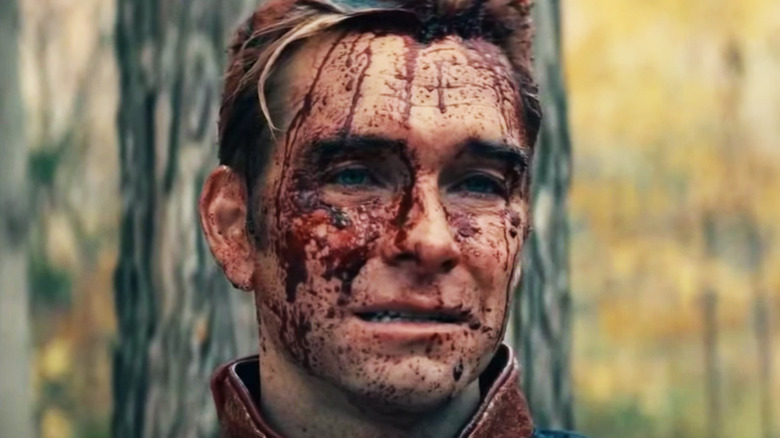
The 3rd season of Amazon's "The Boys" is in production, and fans are eagerly awaiting the release date. The violent, satirical superhero show is based on Garth Ennis and Darick Robertson's comic series of the same name, which concluded in 2012 after 72 issues. There's enough source material in the comics -- and its several spin-offs -- to keep the Eric Kripke-helmed series going for years to come, but how should fans of the TV series and the comics keep themselves occupied during the lengthy gap between seasons?
Many of the tropes present in "The Boys" -- fundamentally flawed heroes and villains, anti-authoritarianism, and unfamiliar spins on familiar characters -- appear in Ennis' other stories, but similar material can also be found in titles from a number of other creators, too. Sometimes, the connection is obvious. Sometimes, less so. Just be wary: As with "The Boys," many of these books are intended for adult audiences, and contain profanity, violence, and sex.
So, with that being said, let's dive in faster than a speeding bullet -- or, more appropriately, faster than a doomed aircraft plummeting towards the sea.
Hitman
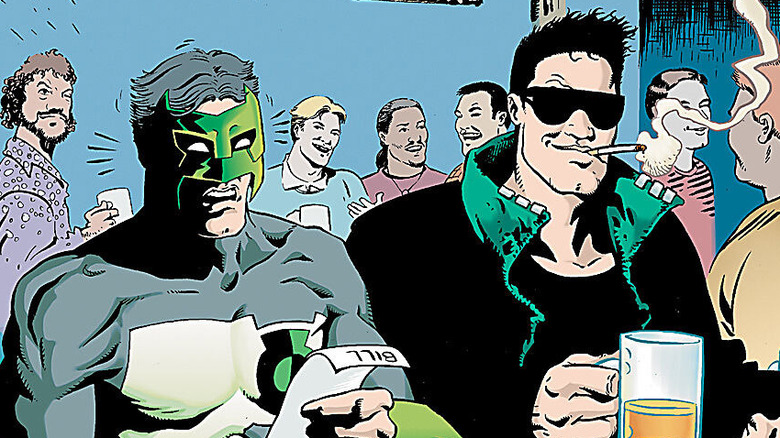
As certain as death and taxes is the fact that, every year, a new universe-wide title-spanning calamity befalls both the Marvel and DC Universes. In the summer of 1993, DC launched the multi-title "Bloodlines" storyline, in which (another) race of aliens invaded Earth, killing humans for their delicious spinal fluid. Some of these victims survived the ordeal and, their metagenes triggered by the encounter, developed superpowers.
Most of these new superheroes met with little success. Tommy Monaghan, a contract killer living in Gotham City, was the exception. Granted X-ray vision and telepathy, Tommy's solo title -- "Hitman," written by "The Boys" co-creator Garth Ennis and drawn by John McCrea -- lasted for 61 issues.
Despite the grim premise (for the most part, Tommy hunts metahumans and supernatural creatures), there's a thick vein of black comedy running through the heart of "Hitman". As with "The Boys," pompous superheroes and their self-importance are the frequent targets of mockery and disdain. Ennis' dislike of superheroes leads to some unforgettable Green Lantern moments, and Batman's rare appearances are the cause of much hilarity.
"Hitman" allowed Garth to explore a variety of topics, ranging from the hilarious (Section 8, a spin-off team composed of failed superheroes) to the supernatural (a demonic rifle stolen from the pages of "Hellblazer") to the poignant (The Troubles in Northern Ireland, and Tommy's fragmented relationship with his own father). Graphic novels of the collected series are expensive, but well worth it, particularly the two-part "Justice League of America" crossover. Tommy and his ilk are sadly missed in the present-day DC Universe, no longer there to bring much-needed levity.
Preacher
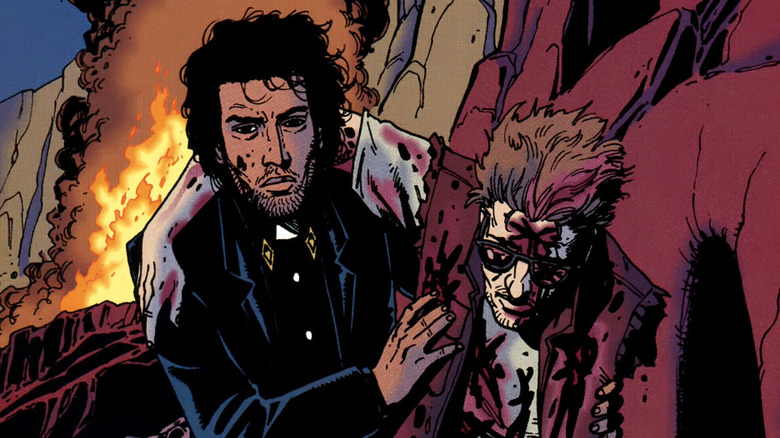
A Preacher, an assassin, and a vampire walk into a bar...
"Preacher" is another Garth Ennis title, one of a few on this list. It finds Jesse Custer, our eponymous hero, desperate and stuck in Nowheresville, USA, losing his faith. However, Genesis, the offspring of an angel and a demon (a theme Ennis visited in "Hellblazer" two years previous), escapes from Heaven and takes up shop in Jesse's consciousness. This grants Jesse the ability to force anybody to follow his instructions, a power that he calls "The Word of God," but makes him a target for those who would seek to exploit his gift or to recapture Genesis.
Part road movie, part Western, "Preacher" follows our hero and his unlikely companions (a 100-year-old Irish Vampire and Tulip, Jesse's ex-girlfriend-turned-hit-girl) as they travel across America's underbelly in search of the missing Almighty. If it's the violence and dark humor of "The Boys" that appeals, "Preacher" has it in spades. A creator-owned title set apart from the rest of the DC Universe, "Preacher" pits our reluctant anti-heroes against a motley crew of supporting characters: serial killers, pretentious vampires, sexual detectives, neo-Nazis, and a millennia-old paramilitary religious order.
If you've seen the "Preacher" TV series and haven't yet read the comics, don't worry. Apart from a few thematic similarities and the central characters, they're entirely different beasts. "Preacher" is still fondly remembered as one of the best comic titles of the late '90s, and not without cause. It's crude, blasphemous, violent, and often hilarious, but is ultimately an optimistic and inspirational story about friendship, brotherhood and redemption.
The Authority
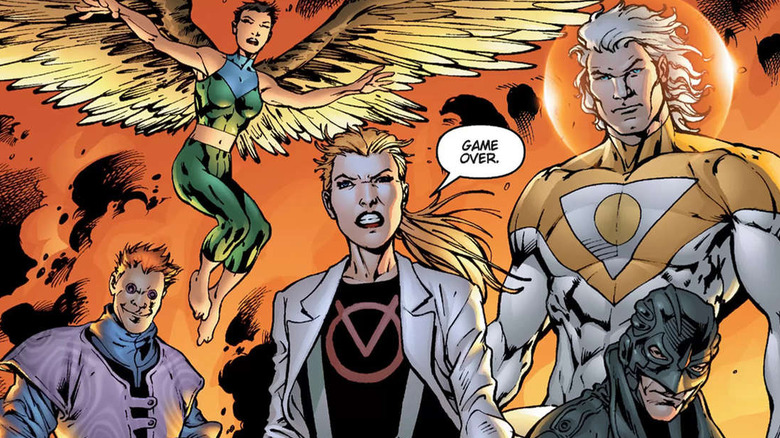
"The Authority," a late-'90s comic series from DC's Wildstorm imprint, saw many creative teams come and go, but the original Warren Ellis and Mark Millar run is this title at its best. Created as an analogue to DC's Justice League, the Authority is a group of super-powered beings who have decided to fix the world by any means available. They're kind of like the Seven with a social conscience.
There's an interesting tenet at the core of the Authority's philosophy: people with the powers of gods shouldn't stand by and let the world suffer. In "The Boys," the Seven use their abilities for self-promotion and gain. The Authority use their powers to topple corrupt governments. As with "The Boys," each character in the Authority has a loose parallel in Justice League, although there are some key differences; the Authority's own takes on Superman and Batman (Apollo and the Midnighter, respectively) are in a relationship with one another, which isn't behavior you'd expect from Homelander and Black Noir. In the early '00s, a thinly-veiled parody of the Authority called the Elite appeared across DC comics, confronting the JLA themselves.
The quality of "The Authority" shifts dramatically depending on who's writing and drawing the book, but we'd recommend reading the first two volumes of the series, "Relentless" and "Under New Management," which collect issues #1 to #16.
Skrull Kill Krew
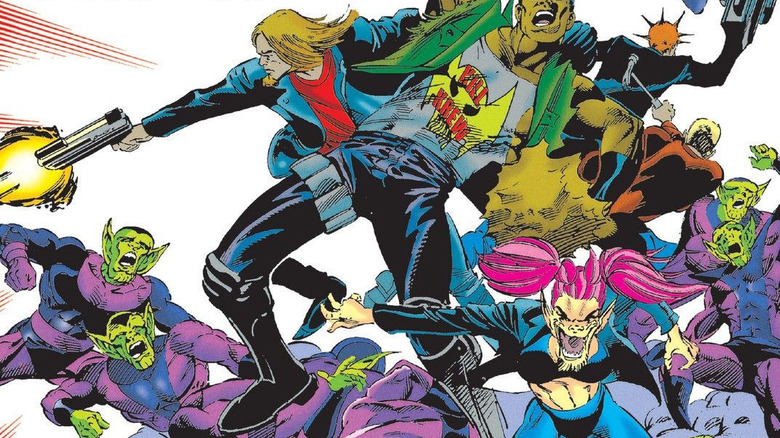
The Fantastic Four's Reed Richards' distinctive patch of white hair isn't his only streak; he also possesses a cruel one a mile wide. In 1962's "Fantastic Four" #2, after a failed invasion by the shape-shifting Skrulls, the Fantastic Four's patriarch hypnotized the remnants of a Skrull invasion party into thinking they were cows, leaving them out to pasture. However, the rustic existence of the bovine trio was short-lived, as they went the way of most cattle: slaughtered, ground into minced beef, lightly seasoned, and processed into burgers.
In 1993, when Mad Cow Disease dominated the headlines, Grant Morrison and Mark Millar introduced us to the Skrull Kill Krew, normal individuals unfortunate enough to have eaten and become contaminated by Skrull-infected beef. The degenerative condition would eventually kill them, but in the meantime gave them both the Skrulls' shape-changing powers and the ability to see through the aliens' disguises.
With Steve Yeowell on art duties, this riotous 5-issue series was an excuse to pit a motley assortment of reluctant heroes against the Skrulls, culminating in an ultra-violent finale in which the Kill Krew faced an entire town of changelings as well as a faux Fantastic Four. If, as with "The Boys," you like seeing underpowered normies take on the heavy hitters, "Skrull Kill Krew" is for you.
Wanted
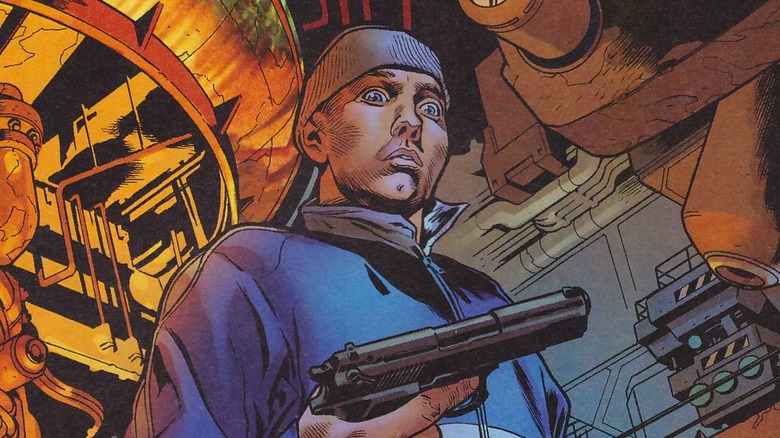
The version of "Wanted" that made it to cinema screens in 2008 was an entertaining action movie, but was also a dramatically watered-down version of the source material. The McAvoy and Jolie vehicle was a typical revenge movie with a few fantastic elements; the comic is a dramatically different entity.
Wesley Gibson is a mild-mannered cubicle worker with a mediocre life who discovers that he is the son of one of the greatest -- and, sadly, deceased -- super-villains of all time. As he inherits his father's mantle, he discovers, much like Neo in the Matrix, that reality is a lie. In the real world, supervillains won long ago, and now hide amongst us in plain sight.
The comic shares the same anarchic feel as "The Boys" comic and TV series, pairing extreme violence with excessive swearing and toilet humor (there's a Clayface-like supervillain who is literally composed of excrement). Once you get over the somewhat jarring fact that Wesley Gibson is clearly based on Marshall Mathers, aka Eminem, it's a glorious romp that, like "The Boys," does a wonderful job deconstructing the world of superheroes and villains. Many of the characters are thinly disguised variations on ones from the Marvel and DC Universes, and it's all the better for it. Whether you enjoyed the film or not, the comic is an interesting glimpse at what it could have been.
Civil War
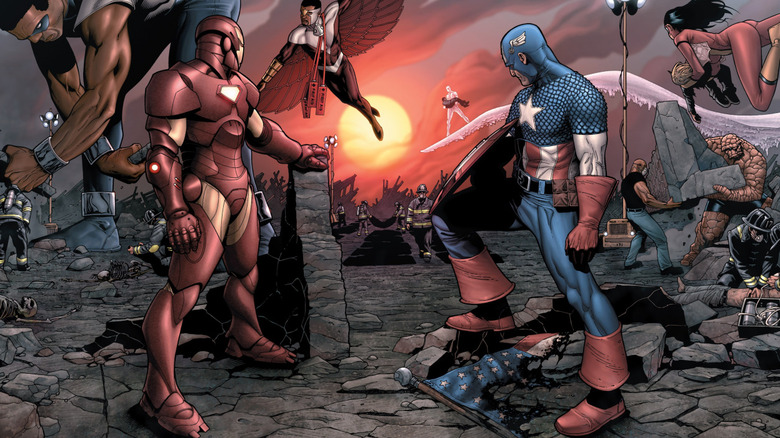
While the movie adaptation of "Civil War" really only showed us the conflict's effects on Captain America and his closest allies, the equivalent storyline in the comics was a sprawling crossover that spanned multiple Marvel comics, impacting every title and character. Its set-up was a little different, too: a battle between the teenage super team the New Warriors and a group of villains results in an explosion that kills 600 innocents on live TV, making authorities decide that unlicensed superheroes cannot be allowed to run amok. And so, the government passes the Superhuman Registration Act. Some heroes, like Iron Man, agree to regulation. Others, like Captain America, see the law as a direct threat to their safety and the safety of those around them.
It could be argued that "The Boys" is a logical extension of the "Civil War" storyline, proving that without a shadow of a doubt, Steve Rogers was in the right. The Seven, despite regulation, operate with impunity. Just as sure as how great power comes with great responsibility, The Seven show that absolute power corrupts absolutely.
Even if you're familiar with the Marvel movie, the "Civil War" collection (and it's 2016 sequel) is different enough that it will still entertain. It goes far more in-depth than a two-and-a-half-hour movie can, and unlike the MCU, which ended up brushing away most of Civil War's lasting impact, the comics are still feeling the effects of the crossover today.
Hellblazer
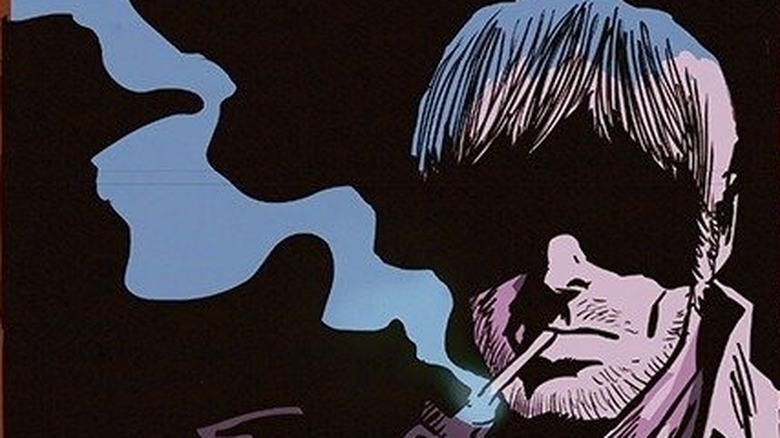
Professional curmudgeon Alan Moore was one of the figureheads of comics' mid-'80s British Invasion, reinvigorating existing DC Comics properties by imbuing them with his own dramatic takes. "The Saga of Swamp Thing" #37, for example, introduced the world to John Constantine. It's never quite recovered.
John Constantine, scouse sorcerer supreme, began as a wisecracking foil to the monosyllabic Guardian of the Green. The cynical Liverpudlian eventually spun off into his own solo series, initially called "Hellblazer," which has existed in one form or another since 1988. The character had a moderately successful movie in "Constantine" (starring Keanu Reeves as the title character alongside a fresh-faced Shia LeBeouf), popped up in "Arrow," had a failed TV series, and is now a regular on "DC's Legends of Tomorrow."
Billy Butcher and John Constantine share a common strand of DNA. Aside from both character's fondness for trench coats, both are loners grudgingly forced into the company of others. They're both cunning and exploitative, and are reluctant to form friendships, all of which inevitably sour. To Butcher and Constantine, colleagues are little more assets to exploit.
A particular highlight of Constantine's ongoing series, and an excellent introduction to the character, can be found in Garth Ennis' run. "Dangerous Habits" sees the magus trapped in his trickiest quandary yet, as his chain-smoking leads to lung cancer. It's a stunning turn as the character realizes he can't talk or trick his way out, forcing him to confront his dark past.
Marshall Law
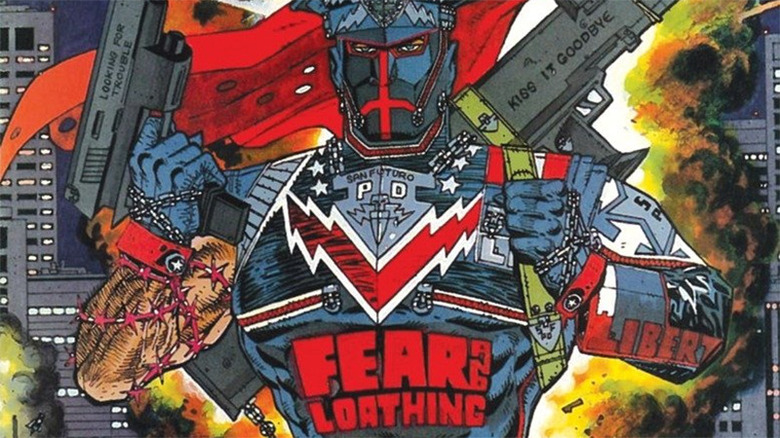
The Godfather of British Comics, Pat Mills, hates superheroes.
The "Marshall Law" comic takes the world of "The Boys" and pushes it to the extreme. The city of San Futuro, built on the earthquake ravaged remains of San Francisco, is a sprawling metropolis with a severe infestation problem. More specifically, it's plagued by superheroes. The world's once valiant defenders have gone rogue, roaming the decaying streets in feral gangs. It'll take a superpowered cop to take them down, one unafraid to carry out the extreme measures necessary.
Marshall Law is a leather-clad proto-fascist, a haunted man who wraps barbed wire around his arm just to prove that he can still feel. Across several storylines, handily collected into a deluxe omnibus released by DC in 2013, he slaughters his way across San Futuro, killing subtle (and not-so-subtle) parodies of the Marvel and DC heroes (there's also a brief journey to Hell to confront Pinhead in a two-part "Hellraiser" crossover).
Anti-authoritarianism is a common feature in Mills' work -- as creator of "2000 AD," he played a major part in creating Judge Dredd, who Marshall Law resembles -- and he delights in the anti-hero's antics. The "Kingdom of the Blind" storyline is a particular highlight, pitting Law against a barely-disguised Batman analogue named Private Eye, leading to the discovery that the hero is harvesting the adrenal glands from his army of Boy Wonders to keep himself young. It's laugh out loud funny, ultra-violent, politically razor-sharp, and a work you can't imagine being illustrated by anyone other than a powerhouse like Kevin O'Neill.
Punisher Kills The Marvel Universe
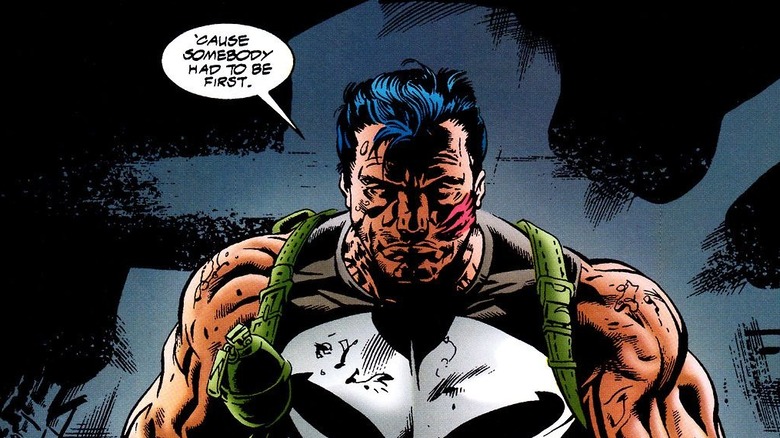
The Punisher isn't the only gun-toting Marvel character to have killed the entirety of the Marvel Comics universe; Deadpool does it so often, it's practically a hobby. Frank Castle -- aka the Punisher -- was the first, though, in a comic oddity that's a "What If..." tale in all but name. And it delivers on that eye-catching title in spades.
Retconning the 1974 one-man-army's origins, Garth Ennis' "Punisher Kills the Marvel Universe" sees Frank Castle go on a vengeance-seeking rampage after his family is killed during a battle between the Avengers, X-Men, and invading aliens. His quest for revenge takes him on a bloody journey through Marvel's main roster, telling a tale that's filled with both black humor and gallons of blood, and yet ends on a surprisingly poignant note as the Punisher realizes he's become the very thing he set out to fight against.
"Punisher Kills the Marvel Universe" made little impact when it was released, and only really gained popularity when Ennis started a lengthy run on the main Punisher titles, which is also highly recommended. Thematically, "Punisher Kills the Marvel Universe" is similar to "The Boys," particularly when Frank Castle has to counter his opponents' various powers (how do you kill a hero with regenerative abilities, anyway?). The original title is hard to obtain, but luckily, it's been included in a number of related graphic novels.
Honorable Mentions
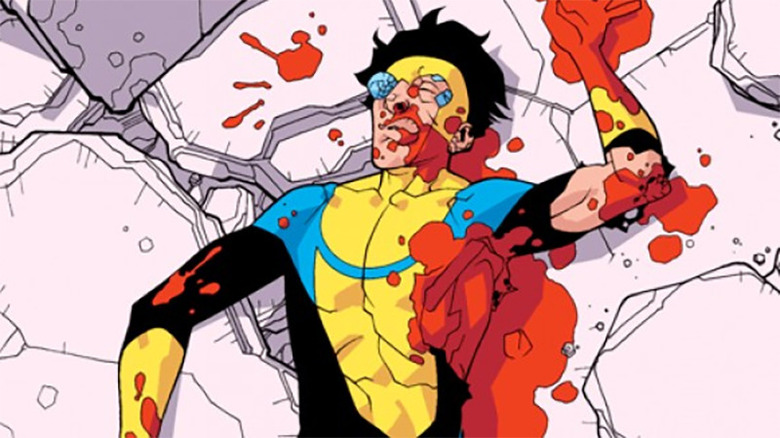
As you can see, fans eager for superhero über-violence are well served by the modern comic industry, as are readers looking for grimness and political satire. But in case that's not enough, here are few notable honorable mentions, the first of which is Robert Kirkman's "Invincible", one of the latest and most memorable comics that asks, 'What if Superman were evil?' That's a question also posited by Mark Millar's "Superman: Red Son," and expounded on in the recent film "Brightburn".
"Zenith," a feature in the British anthology comic "2000 AD," also covered the well-trodden ground of "What if superheroes were jerks?" in the late '80s. The titular character, who was created by Grant Morrison, is little more than a self-serving egomaniac who's more interested in record sales and interviews than saving the world. And then, of course, there are "The Boys" themselves, who are due to return to Amazon Prime in late 2021 or early 2022 alongside a spin-off set in a superhero college.
Read this next: 10 Characters Who Could Bring Fun Back To DC Movies
The post Comics to read if you love The Boys appeared first on /Film.
from /Film https://ift.tt/3kMCciK
via IFTTT
Comments
Post a Comment